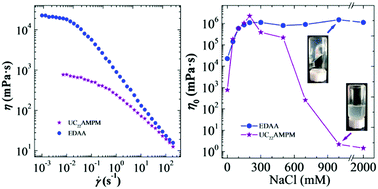The N-allyl substituted effect on wormlike micelles and salt tolerance of a C22-tailed cationic surfactant†
Abstract
Wormlike micelles (WLMs) have been observed in a wide variety of cationic surfactants. Here we developed WLMs based on an N-allyl substituted cationic surfactant with an unsaturated C22-tail, N-erucamidopropyl-N,N-dimethyl-N-allyl-ammonium bromide (EDAA), and compared them with UC22AMPM at the same concentration. The viscoelasticity, aggregate microstructure and salt tolerance of EDAA solutions were investigated by rheology, surface tension and Cryo-TEM measurements. It was found that EDAA exhibited a higher viscosity and a high salt tolerance. Upon increasing the concentration of NaCl, the viscosity of wormlike micelles in the solutions continuously increased and reached ∼1.10 × 106 mP s at 200 mM. On further increasing the NaCl concentration to 2000 mM, the viscosity remained at ∼106 mP s without any reduction. But the viscosity of UC22AMPM solutions showed a drastic change with the increase of NaCl concentration. This drastic variation in rheological behavior is attributed to the presence of the N-allyl substituent. Besides, the EDAA also shows some advantages such as low overlapping concentration(∼2.2 mM) and stable viscosity over the whole pH range.



 Please wait while we load your content...
Please wait while we load your content...